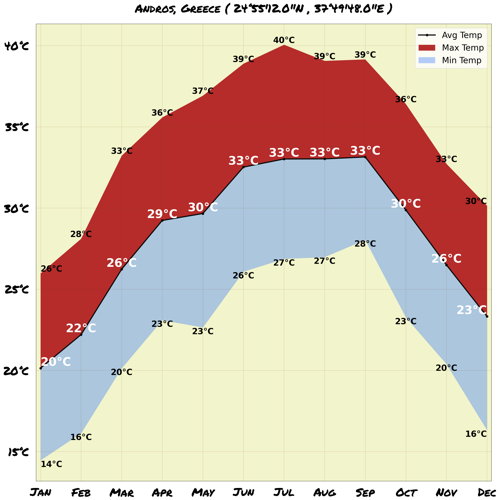Understand
Andros, the northernmost island of the Cyclades, is a hidden gem waiting to be discovered. With its picturesque mountains, lush slopes adorned with citrus and olive trees, enchanting waterfalls, and crystal-clear mountain streams, Andros is a haven of natural wonders. Legend has it that the island was named after its first settler, Andros, a hero descended from the Olympic gods. Throughout history, Andros has been known by different names, all paying tribute to its abundant flora and water springs. During the Classical Age, the island flourished, with its capital located in present-day Paleopolis. The festivities in honor of the god Dionysios, where "water turned to wine," became a major highlight every third year in January. Over the centuries, Andros experienced significant growth. It was captured by the Roman Empire in 133 BC and later came under Venetian rule in 1270. Forts and towers were built during the Venetian period, with the Lower Fort in Chora and the Upper Fort in Kohilou being the most remarkable. Andros became an essential hub for the silk textile trade industry, fueling five centuries of economic prosperity. Andros is much larger than one might imagine, offering numerous villages and towns along its varied coasts. The island's interior is characterized by rugged mountains and rocky landscapes, dotted with farms and charming churches. Gavrio, a quaint port town, serves as the gateway to Andros. A short scooter ride away, you'll find the picturesque beach town of Batsi. The eastern coast is home to the largest town, Chora or Andros, which can be reached by ferries and buses. When planning a visit to Andros, it's essential to clarify whether you are referring to the town or the entire island. Pay close attention to the location of your accommodations as not all places are listed on Google Maps. Make sure to choose a spot close to restaurants and beaches to fully enjoy all that Andros has to offer.
Map & Climate
Popular Foods
 Dolmas - Dolmas are grape leaves stuffed with seasoned rice, minced meat, and herbs. The filling typically includes ground beef or lamb, onions, garlic, and spices, all wrapped in tender grape leaves and cooked in a flavorful broth. <
Dolmas - Dolmas are grape leaves stuffed with seasoned rice, minced meat, and herbs. The filling typically includes ground beef or lamb, onions, garlic, and spices, all wrapped in tender grape leaves and cooked in a flavorful broth. < Moussaka - Moussaka is a layered dish consisting of eggplant, ground meat (usually lamb or beef), and a béchamel sauce. It's often topped with a cheese sauce and baked until bubbly and golden. Vegetarian moussaka alternatives exist without the ground meat. <
Moussaka - Moussaka is a layered dish consisting of eggplant, ground meat (usually lamb or beef), and a béchamel sauce. It's often topped with a cheese sauce and baked until bubbly and golden. Vegetarian moussaka alternatives exist without the ground meat. < Tzatziki - Tzatziki is a refreshing yogurt-based sauce made with cucumber, garlic, olive oil, vinegar, and dill. It's traditionally served as a dip or condiment alongside grilled meats, gyros, and other dishes. Tzatziki is typically non-vegetarian due to the presence of yogurt, but it can be easily adapted to be vegetarian. <
Tzatziki - Tzatziki is a refreshing yogurt-based sauce made with cucumber, garlic, olive oil, vinegar, and dill. It's traditionally served as a dip or condiment alongside grilled meats, gyros, and other dishes. Tzatziki is typically non-vegetarian due to the presence of yogurt, but it can be easily adapted to be vegetarian. <




Comments
NO COMMENTS